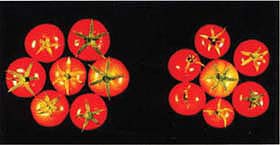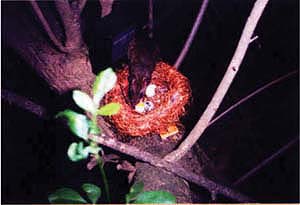All Issues
Genetically engineered tomato grows in salty water
Publication Information
California Agriculture 55(5):4-4.
Published September 01, 2001
PDF | Citation | Permissions
Full text
Nearly 25 million acres of formerly productive agricultural land is lost annually worldwide to irrigation-induced salinity. When grown in salty water with 200mM concentrations of sodium chloride, wild-type tomatoes shrivel up and die, top, while a genetically engineered salt-tolerant tomato plant thrives, bottom.
Genetically engineered fruit grown in saline conditions, right, is of similar quality to that produced under normal conditions, left.
Plant biologists at UC Davis and the University of Toronto have developed a genetically engineered tomato plant that thrives in salty irrigation water. Their unprecedented feat may help growers worldwide to cope with the ancient and eventually devastating dilemma of salt buildup, or salinity, in irrigated soils.
UC Davis pomologist Eduardo Blumwald and colleagues have demonstrated that the tomatoes will grow and produce fruit in irrigation soil and water about 50 times saltier than normal. The plants were irrigated with water having a salt concentration of 200 millimole (mM) sodium chloride, about one-third as salty as seawater.
“Since environmental stress due to salinity is one of the most serious factors limiting the productivity of crops, this innovation could have significant implications for agriculture worldwide,” Blumwald says. The research, much of which was done at the University of Toronto, will continue at UC Davis; the most recent findings were published in the August issue of Nature Biotechnology.
Irrigation increases the salinity of soils by depositing soluble salts such as sodium, calcium, magnesium, potassium, sulfate and chloride, which the water picks up as it passes through soils and rocks. Worldwide an estimated 24.7 million acres of once agriculturally productive land — about one-fifth the area of California — are lost annually because of irrigation-induced salinity, according to the U.S. Department of Agriculture. Crop production is already limited by salinity on 40% of the world's and 25% of the United States' irrigated land. Salty irrigation water upsets the ability of plants to take up water through root cells. If salt concentrations in the soil are very high, water flow into the plant is actually reversed and the plant dehydrates and dies.
To counter this effect, Blumwald and Hong-Xia Zhang of University of Toronto genetically engineered tomato plants that produce higher levels of a naturally occurring protein known as a “transport protein.” The gene that controls increased production of the transport protein was taken from Arabidopsis, a relative of the cabbage that is commonly used in plant research.
The transport protein uses energy available in the cells to move salt — in the form of sodium ions — into compartments within the cells called vacuoles. Once the salt is stashed inside the vacuoles it is isolated from the rest of the cell and unable to interfere with the plant's normal biochemical activity.
The genetically engineered salt-tolerant plants actually remove salt from the soil. Because their salt-storing activity occurs only in the plants' leaves, the quality of the tomato fruit is maintained. Blumwald predicts that it may be possible to develop commercially useful salt-tolerant tomato plants within 3 years.
Caught rat-handed
Researchers with the Point Reyes Bird Observatory and The Nature Conservancy have noticed poor nesting success among song-birds at the Cosumnes River Preserve in Sacramento County in recent years. In May and June, UC Davis wildlife biologists Andy Engilis and Desley Whisson planted 30 imitation songbird nests with quail eggs in riparian forests on the preserve. Using cameras triggered by infrared sensors, they discovered that more than 90% of nest predators were black rats, above. Black rat predation “was a lot more serious than we expected,” Engilis says. Nonnative black rats were introduced into California by European settlers and are now common. The next steps will be to find out whether black rat predation is a problem elsewhere in the Central Valley and investigate methods to manage it.







